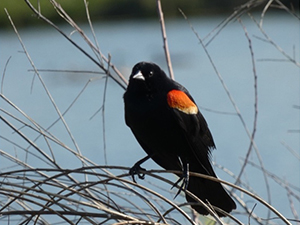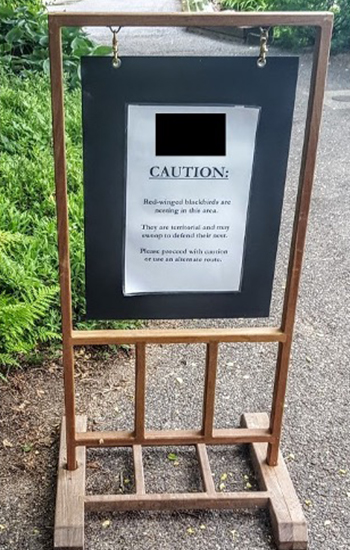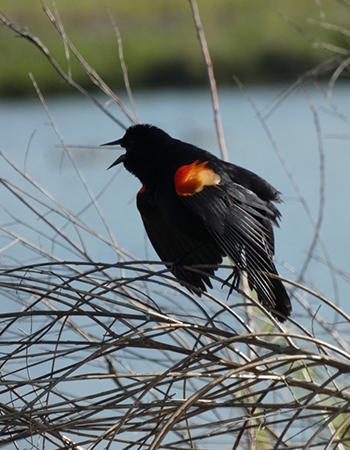How to Manage and Deter Red-winged Blackbirds
May 23, 2023
The Red-winged Blackbird is well known for many things: its melodious song, its vibrantly colored plumage – and its combative nature. During nesting season in the late spring through mid-summer, these birds pack a particularly aggressive punch: any creature that enters their territory will be subject to attack, regardless of their size or the danger they present.
Males – after whom the species is named – can be easily identified by their glossy, jet black feathers and flashy, almost fluorescent red and yellow wing patches. The more subdued females are often mistaken for sparrows. Their muted brown feathers camouflage them from predators and allow them to inconspicuously tend to their nests.
Red-winged Blackbirds can be found in rural, suburban and urban areas and commonly nest near retention ponds, cattails and seed feeders. Males often mate with several females in his territory (sometimes up to 15!) and typically spend nesting season defending his mates and young from potential threats, sometimes including large birds like herons and bald eagles. If aggressive displays of feather fluffing and singing don’t ward off real or perceived threats, Red-winged Blackbirds will resort to physical attacks.
Red-winged Blackbirds: The Dangers to People, Pets & Crops

Birds aren’t the only ones who need to watch their backs around Red-winged Blackbirds. The species has been known to attack people and pets who enter their territory. Their habit of divebombing unsuspecting passersby sometimes forces parks to close pathways around their nesting areas.
The damage caused by Red-winged Blackbirds doesn’t stop at physical harm – their feeding habits can cost farmers millions of dollars a year. Red-winged Blackbirds, along with other species of blackbirds, can cause $150 million dollars’ worth of damage to corn, sunflower and rice crops per year according to the USDA.
Later, in the waning days of summer through fall, blackbirds form large, multi-species flocks that include both adult and immature birds. When these flocks descend on agricultural fields, their accumulated waste can threaten human and livestock health.
Prevent Red-winged Blackbird Conflicts with Biology-Based Solutions

Territorial display and song
As native migratory birds, Red-winged Blackbirds and their nests are protected by the Migratory Bird Treaty Act of 1918 (MBTA). That means dealing with these nuisance birds is not always easy or straightforward: as a protected species, it is unlawful to kill, injure or transport the birds (or their nests) without permission from the U.S. Fish & Wildlife Service.
Luckily, Wild Goose Chase Indy can help manage Red-winged Blackbird conflicts on your property or farm.
The Wild Goose Chase Indy team offers customized plans and biology-based solutions to manage nesting blackbirds legally and humanely.
One solution that has proven to deter Red-winged Blackbirds and other birds from damaging crops is the use of automatic lasers. Systems like the AVIX Mark II are fully automated, humane, noiseless, customizable and ultra-effective. Automatic lasers run 24/7 and sweep fields in random patterns so birds can’t habituate to and avoid the sweep of beams.
For more information about automatic lasers and other deterrent strategies, contact an expert member of the Wild Goose Chase Indy team today.
Contact us today to learn more about our bird control solutions


 0
0
